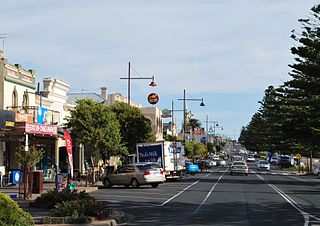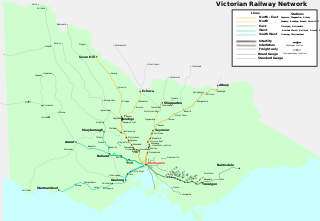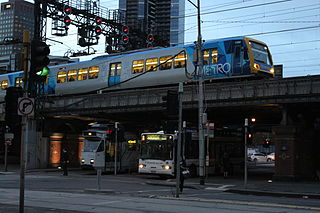Geelong is a port city in the southeastern Australian state of Victoria, located at the eastern end of Corio Bay and the left bank of Barwon River, about 65 km (40 mi) southwest of Melbourne, the state capital of Victoria.

Port Phillip or Port Phillip Bay is a horsehead-shaped enclosed bay on the central coast of southern Victoria, Australia. The bay opens into the Bass Strait via a short, narrow channel known as The Rip, and is completely surrounded by localities of Victoria's two largest cities — metropolitan Greater Melbourne in the bay's main eastern portion north of the Mornington Peninsula, and the city of Greater Geelong in the much smaller western portion north of the Bellarine Peninsula. Geographically, the bay covers 1,930 km2 (750 sq mi) and the shore stretches roughly 264 km (164 mi), with the volume of water around 25 km3 (6.0 cu mi). Most of the bay is navigable, although it is extremely shallow for its size — the deepest portion is only 24 m (79 ft) and half the bay is shallower than 8 m (26 ft). Its waters and coast are home to seals, whales, dolphins, corals and many kinds of seabirds and migratory waders.

Portland is a city in Victoria, Australia, and is the oldest European settlement in the state. It is also the main urban centre in the Shire of Glenelg and is located on Portland Bay. As of the 2021 census the population was 10,016, increasing from a population of 9,712 taken at the 2016 census.

Corio Bay is one of numerous internal bays in the southwest corner of Australia's Port Phillip, and is the bay on which abuts the City of Geelong. The nearby suburb of Corio takes its name from Corio Bay.

Rail transport in the Australian state of Victoria is provided by a number of railway operators who operate over the government-owned railway lines. The network consists of 2,357 km of Victorian broad gauge lines, and 1,912 km of standard gauge freight and interstate lines; the latter increasing with gauge conversion of the former. Historically, a few experimental 762 mm gauge lines were built, along with various private logging, mining and industrial railways. The rail network radiates from the state capital, Melbourne, with main interstate links to Sydney and to Adelaide, as well as major lines running to regional centres, upgraded as part of the Regional Fast Rail project.

The Port of Melbourne is the largest port for containerised and general cargo in Australia. It is located in Melbourne, Victoria, and covers an area at the mouth of the Yarra River, downstream of Bolte Bridge, which is at the head of Port Phillip, as well as several piers on the bay itself. Since 1 July 2003, the Port of Melbourne has been managed by the Port of Melbourne Corporation, a statutory corporation created by the State of Victoria.

Bellarine Highway is a main arterial highway that runs east from Geelong in Victoria along the Bellarine Peninsula to Queenscliff. The highway also provides the main route to Barwon Heads and Ocean Grove, localities along the southern coast of the peninsula.

Transport in Melbourne, the state capital of Victoria, Australia, consists of several interlinking modes. Melbourne is a hub for intercity, intracity and regional travel. Road-based transport accounts for most trips across many parts of the city, facilitated by Australia's largest freeway network. Public transport, including the world's largest tram network, trains and buses, also forms a key part of the transport system. Other dominant modes include walking, cycling and commercial-passenger vehicle services such as taxis.
Blue Wedges is a conservation organisation in conflict with Australia's Victorian government policy to deepen shipping channels in Port Phillip and the large scale development of Ramsar listed Westernport. The Blue Wedges is a coalition of over 65 environmental and bay user groups opposed to development in the Melbourne Bays that they deem to be unsustainable, such as the Port of Melbourne Corporation's Channel Deepening Project. The Blue Wedges Coalition includes angling groups and peak bodies, professional fishing associations, diving and charter operators along with the more traditional coastal protection groups and bayside industry sectors. The Blue Wedges Coalition is supported in its goal to protect the bays by other environmental entities including the Victorian National Parks Association, Australian Conservation Foundation, Friends of the Earth, The Wilderness Society, Environment Victoria, Port Phillip Conservation Council and Western Region Environment Centre under a joint statement issued by these groups opposing the project and calling for action to stop the project from the Victorian Government.

The Port of Geelong is located on the shores of Corio Bay at Geelong, Victoria, Australia. The port is the sixth-largest in Australia by tonnage.

The Port Phillip Channel Deepening Project (CDP) began on 8 February 2008 to deepen the shipping channels leading to Melbourne, Australia.

The Warrnambool railway line is a railway serving the south west of Victoria, Australia. Running from the western Melbourne suburb of Newport through the cities of Geelong and Warrnambool, the line once terminated at the coastal town of Port Fairy before being truncated to Dennington. This closed section of line has been converted into the 37 km long Port Fairy to Warrnambool Rail Trail. The line continues to see both passenger and freight services today.

The Port of Melbourne Corporation (PoMC) is a statutory body established by the Victorian Government to develop and manage the Port of Melbourne, Australia's busiest container port. The Corporation commenced operations on 1 July 2003, when it took over the management of the port from the Melbourne Port Corporation. On 1 September 2010, the corporation was re-established with a new charter under the Transport Integration Act.

Point Lonsdale Lighthouse, also known as the Point Lonsdale Signal Station, is close to the township of Point Lonsdale in the Borough of Queenscliffe, Victoria, Australia. It stands at the eastern end of the Bellarine Peninsula, on the western side of the entrance to Port Phillip from Bass Strait, on a headland overlooking the "Rip", a stretch of water considered one of the ten most treacherous navigable passages in the world, and the only seaborne approach to Melbourne. It is operated by Victorian Ports Corporation (Melbourne).
The Port of Hastings Development Authority is an authority of the Government of Victoria, Australia. The authority is responsible for the development and management of the port of Hastings located in Western Port Bay approximately 72 kilometres to the south east of Melbourne. The port is expected to be developed by the authority as a major new container port in competition with the Port of Melbourne, Australia's busiest container port.
The Melbourne Harbor Trust was established in 1877 to improve and operate port facilities for the growing city of Melbourne. It was superseded by the Port of Melbourne Authority in 1978 and later by the Port of Melbourne Corporation.
The Department of Economic Development, Jobs, Transport and Resources (DEDJTR) is a former department of the Government of Victoria. It was created on 1 January 2015 by the government of Premier Daniel Andrews when the number of government departments was reduced from 9 to 7, and assumed responsibility for ministerial portfolios previously spread across 5 departments. It was abolished at the end of 2018 and divided into two new departments.
The Victorian Ports Corporation (Melbourne) (VPCM) is a statutory authority of the Government of Victoria created to succeed the Port of Melbourne Corporation as the government regulator of shipping in Port Phillip Bay after the lease of the Port of Melbourne in 2016. In 2021, it was merged with the Victorian Regional Channels Authority into a new agency, Ports Victoria.

Rail Projects Victoria (RPV) is an agency of the Government of Victoria, Australia, responsible for the management of certain major infrastructure projects on the Victorian rail network. Originally established as the Melbourne Metro Rail Authority (MMRA), to deliver the Melbourne Metro Rail Project, the office was later expanded in its responsibilities to include the management and planning of a number of major infrastructure programs on V/Line's regional rail services. It was renamed RPV in 2018 to reflect its expanded scope, and later became one of several project teams comprising the Department of Transport's Major Transport Infrastructure Authority.












